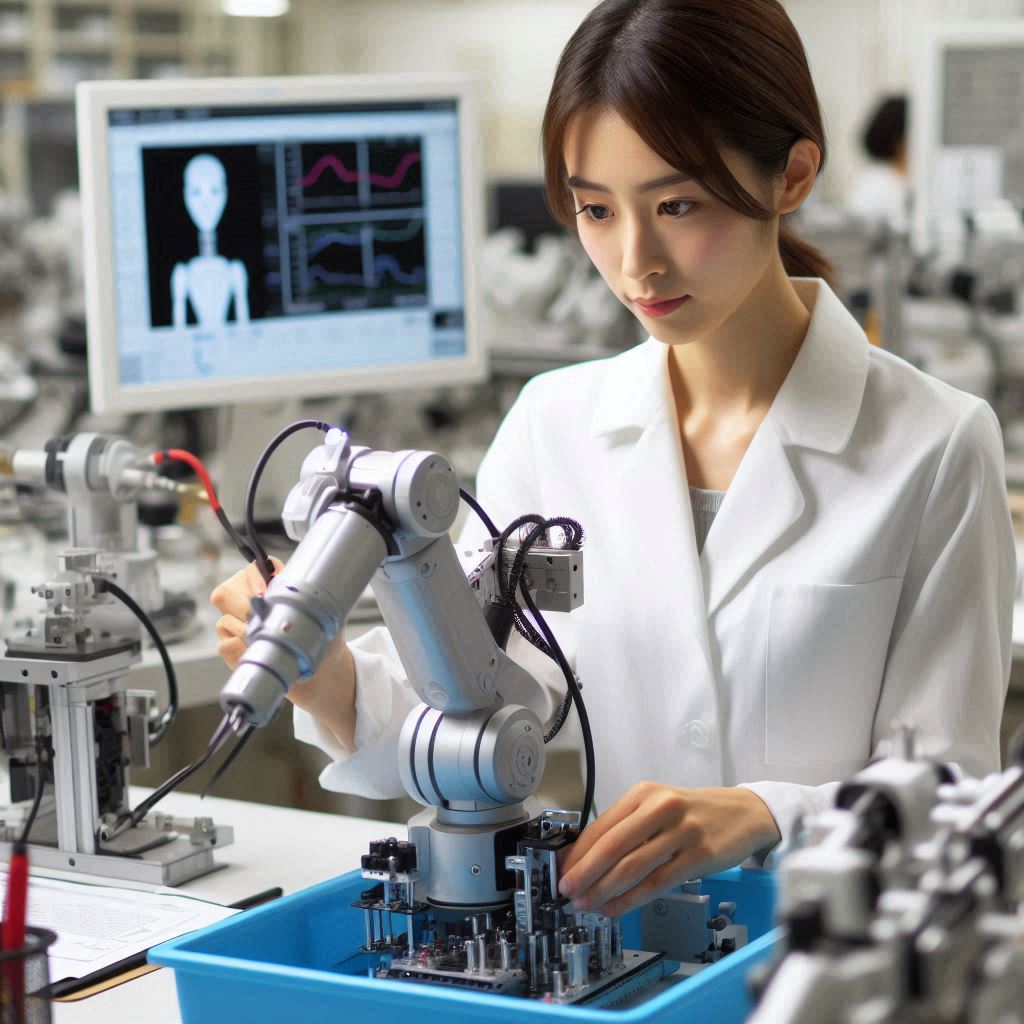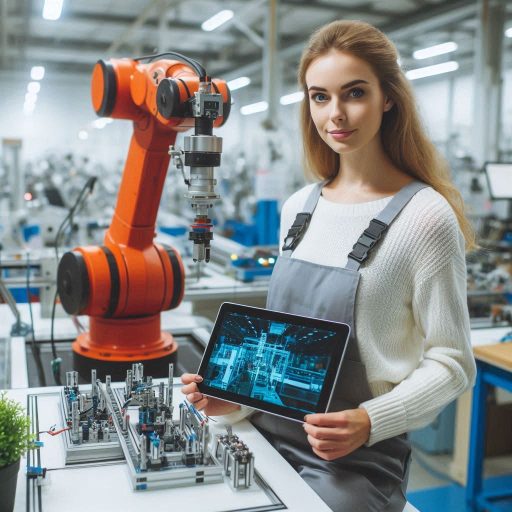Introduction
Robotics engineers are making significant strides in education by developing and integrating cutting-edge technologies into the classroom.
Their innovations are reshaping traditional teaching methods and enhancing the learning experience.
By incorporating robotics into educational settings, engineers are creating interactive and engaging tools that make complex subjects more accessible and enjoyable for students.
The role of robotics engineers in education involves designing and implementing robots that facilitate hands-on learning and stimulate student interest in STEM fields.
Robotics in the classroom allows students to interact with technology in a practical way, bridging the gap between theoretical knowledge and real-world applications.
These robots are not only used for teaching programming and engineering concepts but also for promoting critical thinking, problem-solving, and creativity.
The impact of robotics on the education sector is profound.
Robotics tools and platforms enable personalized learning experiences, adapting to individual students’ needs and learning styles.
This customization helps cater to diverse educational requirements, making learning more inclusive and effective.
Additionally, robotics fosters collaboration among students, as they work together to build and program robots, enhancing teamwork and communication skills.
Importance of Robotics Engineers in Education
Role of Robotics Engineers in Shaping the Future of Education
Robotics engineers are instrumental in shaping the future of education by bringing innovative technologies into classrooms.
Their role involves designing, developing, and implementing robots that enhance the learning experience and modernize traditional teaching methods.
By creating educational robots, these engineers introduce new tools that engage students and make complex subjects more accessible.
Robotics engineers help bridge the gap between theoretical knowledge and practical application, ensuring that students can interact with technology in meaningful ways.
Their work supports the development of interactive and immersive learning environments that foster student engagement and improve educational outcomes.
As education increasingly incorporates technology, robotics engineers are at the forefront of transforming how subjects are taught and learned, making education more relevant and impactful for today‘s students.
How Robotics Can Enhance the Learning Experience for Students
Robotics enhances the learning experience by offering hands-on, practical learning opportunities that go beyond traditional classroom methods.
Educational robots enable students to engage directly with technology, providing them with real-world applications of programming, engineering, and problem-solving skills.
These interactive tools make abstract concepts more tangible, helping students grasp complex ideas through practical experimentation.
For instance, robots can simulate real-world scenarios that students can interact with, allowing them to apply theoretical knowledge in a practical context.
Robotics also supports personalized learning by adapting to individual students’ needs and learning paces.
Educational robots can provide tailored feedback and adjust their interactions based on a student’s progress, ensuring that each student receives the support they need to succeed.
This adaptability makes learning more inclusive, accommodating diverse learning styles and abilities, and fostering a more effective educational experience.
The Need for Skilled Professionals in This Field
The growing role of robotics in education highlights the increasing demand for skilled professionals in robotics engineering.
These experts are essential for designing, developing, and maintaining the educational robots and systems that are revolutionizing the classroom.
Their expertise ensures that these technologies are effective, safe, and aligned with educational standards.
As robotics technology continues to advance, the need for highly trained engineers who can innovate and address emerging challenges becomes more critical.
Skilled professionals in robotics engineering are not only responsible for creating advanced educational tools but also for keeping up with rapid technological changes and integrating new advancements into educational practices.
Continuous professional development and training are vital for these engineers to stay current with the latest technologies and methodologies.
As robotics increasingly becomes a central component of modern education, the contributions of skilled engineers will be crucial in driving further innovation and improving student learning outcomes.
Their work will continue to shape the future of education, making it more interactive, personalized, and effective.
Innovations in Robotics Education
Exploring the Latest Trends and Advancements in Robotics Education
Robotics education is rapidly evolving with the latest trends and advancements.
Integrating robotics into educational curricula enhances student engagement and learning.
Educational robots now feature advanced capabilities like AI and machine learning, which make learning more interactive and personalized.
These robots can adapt to students’ learning styles, providing tailored instruction and immediate feedback.
The rise of robotics kits and platforms designed for educational purposes has made it easier for schools to incorporate robotics into their programs.
These kits offer hands-on learning experiences, allowing students to build and program robots.
This practical approach helps students grasp complex concepts in science, technology, engineering, and mathematics (STEM).
Virtual and augmented reality (VR and AR) are also becoming popular tools in robotics education.
They create immersive learning environments that enhance understanding and retention of complex topics.
How Robotics Engineers Are Revolutionizing Teaching Methods
Robotics engineers are transforming traditional teaching methods with innovative approaches.
They develop educational robots that facilitate active learning and problem-solving.
These robots enable students to explore and experiment with programming, electronics, and mechanical engineering in a hands-on manner.
By engaging directly with technology, students develop critical thinking and technical skills that are crucial for future careers.
Engineers are also creating sophisticated simulation software that complements physical robotics kits.
This software allows students to test and refine their designs virtually before building them.
It reduces the cost and complexity of physical prototypes and accelerates the learning process.
Additionally, robotics engineers are integrating collaborative platforms that encourage teamwork and peer learning.
These platforms enable students to work on joint projects, fostering collaboration and communication skills.
Examples of Innovative Robotics Programs in Schools and Universities
Several schools and universities are leading the way with innovative robotics programs.
At the primary and secondary levels, programs like FIRST Robotics and VEX Robotics provide students with competitive and educational robotics experiences.
These programs challenge students to design, build, and program robots for various competitions, enhancing their problem-solving and engineering skills.
In higher education, universities are developing cutting-edge robotics programs that prepare students for careers in the field.
For example, Carnegie Mellon University offers a Robotics Institute with specialized degrees and research opportunities.
The institute focuses on advancing robotics technologies and applying them to real-world problems.
Similarly, MIT‘s Department of Mechanical Engineering provides students with hands-on experience through its Robotics Research Group, where they work on pioneering projects in robotics.
Moreover, educational institutions are partnering with industry leaders to offer real-world applications of robotics technology.
For instance, Stanford University collaborates with tech companies to provide students with internships and research opportunities in robotics.
These partnerships help bridge the gap between academic learning and practical experience, preparing students for the demands of the robotics industry.
In general, robotics education is advancing rapidly with new trends and technologies.
Robotics engineers are revolutionizing teaching methods by creating interactive, hands-on learning experiences.
Innovative robotics programs in schools and universities are providing students with valuable skills and preparing them for future careers in robotics and STEM fields.
Read: Tips for Writing Environmental Engineering Reports
Collaboration with Educators
Collaborative Efforts Between Robotics Engineers and Educators
Robotics engineers and educators are working together to transform education.
This collaboration merges technical expertise with pedagogical strategies, creating innovative learning experiences.
Engineers bring advanced robotics technology, while educators provide insights into effective teaching methods.
This partnership results in engaging and interactive educational tools that captivate students‘ interest in STEM fields.
For instance, robotics engineers help design educational robots tailored to classroom needs.
These robots are often used in coding and robotics courses, making abstract concepts tangible.
Educators, in turn, adapt these tools to align with curriculum standards and learning objectives.
This synergy ensures that the technology effectively supports educational goals.
Benefits of Cross-Disciplinary Partnerships in Enhancing Education
Cross-disciplinary partnerships between robotics engineers and educators offer several benefits.
First, they bridge the gap between theoretical knowledge and practical application.
Students gain hands-on experience with robotics, enhancing their understanding of complex concepts.
This practical approach fosters a deeper grasp of subjects like mathematics and science.
Second, such collaborations foster creativity and problem-solving skills.
When students work with robots, they engage in real-world problem-solving scenarios.
This experience helps develop critical thinking and adaptability, essential skills in the modern workforce.
Third, these partnerships promote enthusiasm for STEM careers.
By interacting with cutting-edge technology, students become more excited about pursuing careers in robotics and engineering.
Exposure to robotics early in their education can inspire future engineers and scientists.
Teamwork is Essential for the Success of Robotics Education Initiatives
Teamwork between robotics engineers and educators is crucial for the success of robotics education initiatives.
Engineers provide the technical expertise required to build and program robots, while educators offer insights into student learning needs and classroom dynamics.
This collaboration ensures that educational tools are not only technically advanced but also pedagogically effective.
Effective communication between engineers and educators is key.
Regular meetings and feedback sessions help align objectives and refine tools based on classroom experiences.
This iterative process leads to continuous improvement and ensures that robotics initiatives meet educational goals.
Furthermore, teamwork extends beyond engineers and educators.
Successful robotics education initiatives often involve parents, students, and industry partners.
Engaging these stakeholders helps create a supportive environment for students and provides additional resources and expertise.
Generally, the collaboration between robotics engineers and educators is driving innovation in education.
Cross-disciplinary partnerships offer numerous benefits, including practical learning experiences and increased enthusiasm for STEM careers.
Teamwork among all involved parties is essential for developing and implementing successful robotics education initiatives, ensuring they are both effective and engaging for students.
Read: Public Health and Environmental Engineering

Impact on Student Learning
Impact of Robotics Education on Student Learning Outcomes
Robotics education significantly impacts student learning outcomes by enhancing engagement and understanding of complex concepts.
Students exposed to robotics learn practical applications of STEM principles.
This hands-on experience helps them grasp abstract theories through tangible examples.
Robotics projects encourage active participation and collaboration, leading to a deeper understanding of subjects.
The integration of robotics in education fosters interest in science, technology, engineering, and mathematics.
By working with robots, students develop skills that are increasingly valuable in the modern job market.
This approach not only improves academic performance but also prepares students for future careers in technology and engineering fields.
How Hands-On Experience with Robots Can Improve Critical Thinking and Problem-Solving Skills
Hands-on experience with robots enhances critical thinking and problem-solving skills by providing real-world challenges.
When students program and control robots, they face technical issues and design problems.
Solving these challenges requires analytical thinking and creative solutions.
Robotics projects often involve trial and error, helping students learn from failures and improve their approach.
This iterative process develops resilience and adaptability.
Students must troubleshoot problems, optimize designs, and make decisions based on data.
These experiences build strong problem-solving skills and enhance their ability to think critically.
Robotics education thus equips students with the skills needed to tackle complex problems in various fields.
Success Stories of Students Who Have Benefitted from Robotics Education
Many students have thrived thanks to robotics education, showcasing its transformative impact.
For instance, a high school team from Texas won a national robotics competition, demonstrating their advanced programming and engineering skills.
This achievement opened doors for scholarships and career opportunities in STEM fields.
Similarly, a group of middle school students in California developed a robot that helps automate tasks in local community centers.
Their project not only improved their problem-solving abilities but also positively impacted their community.
Another success story involves a student who created a robot to assist in elderly care, gaining recognition and support for further innovation.
These success stories highlight how robotics education fosters skills and opportunities, empowering students to excel and make meaningful contributions.
Read: Environmental Engineering and Marine Conservation
Addressing Challenges in Robotics Education
Common Challenges Faced by Robotics Engineers in Implementing Education Programs
Robotics engineers face several challenges when implementing educational programs.
One major challenge is limited funding and resources.
Many schools struggle to afford advanced robotics kits and technology.
This lack of resources can hinder the development of effective robotics programs.
Another challenge is the lack of trained educators.
Teachers may need more expertise and training to effectively integrate robotics into their curricula.
Transform Your Career Today
Unlock a personalized career strategy that drives real results. Get tailored advice and a roadmap designed just for you.
Start NowAdditionally, there can be resistance to adopting new technologies.
Some educators and administrators may prefer traditional teaching methods.
Technical issues and maintenance of robotics equipment also pose challenges.
Ensuring that robots and related technology remain functional and up-to-date requires ongoing support and repairs.
Strategies for Overcoming Obstacles in Robotics Education
To overcome these obstacles, robotics engineers can adopt several strategies.
Securing grants and partnerships can help address funding shortages.
Collaborating with tech companies and nonprofits can provide schools with the necessary resources and support.
Offering professional development for educators is crucial.
Training teachers in robotics and technology can help them effectively incorporate these tools into their lessons.
Promoting the benefits of robotics education to administrators and stakeholders can help reduce resistance.
Demonstrating how robotics can enhance learning outcomes and prepare students for future careers can garner support.
Implementing robust maintenance and support plans for robotics equipment can also mitigate technical issues.
Regular check-ups and technical support ensure that equipment remains in good working order.
Solutions to Improve Access and Inclusivity in Robotics Education
Improving access and inclusivity in robotics education is essential.
One solution is to develop low-cost or open-source robotics kits.
These kits can make robotics education more affordable for schools with limited budgets.
Offering online resources and virtual robotics platforms can also expand access.
These platforms provide students with remote learning opportunities and access to robotics education without requiring physical equipment.
Increasing outreach and creating programs targeted at underrepresented groups can promote inclusivity.
Schools and organizations can host workshops and events that encourage diverse participation in robotics.
Providing scholarships and financial aid for robotics programs can help students from low-income backgrounds participate.
Building partnerships with community organizations can further enhance access.
These partnerships can offer additional resources, mentorship, and support to schools and students.
Creating a network of support can help schools implement and sustain effective robotics education programs.
In essence, robotics engineers encounter challenges in implementing education programs, such as limited resources and resistance to new technologies.
Strategies to overcome these obstacles include securing funding, offering educator training, and addressing technical issues.
Solutions to improve access and inclusivity involve developing affordable robotics kits, expanding online resources, and increasing outreach efforts.
By addressing these challenges and implementing effective solutions, robotics education can become more accessible and inclusive, benefiting a broader range of students.
Read: Environmental Engineering Software and Tools
Delve into the Subject: How to Write a Winning Mining Engineer Resume
Future of Robotics in Education
Predicting Future Trends in Robotics Education
Robotics education is rapidly evolving, with future trends promising exciting changes.
One key trend is the increasing integration of artificial intelligence (AI) in educational robots.
AI-powered robots will offer personalized learning experiences, adapting to each student‘s pace and skill level.
This adaptability ensures that all students receive the support they need to excel.
Another trend is the use of virtual and augmented reality (VR/AR) in robotics education.
VR and AR technologies can create immersive learning environments where students interact with robots in virtual settings.
These technologies will enhance understanding and engagement by providing hands-on experiences without physical limitations.
Robotics education will also see a greater emphasis on interdisciplinary learning.
Future curricula will integrate robotics with subjects like biology, chemistry, and engineering.
This integration will help students see the real-world applications of robotics across various fields.
Potential Advancements in Technology
Several technological advancements could shape how we teach and learn with robotics.
Advances in machine learning will enable robots to perform more complex tasks and interact more naturally with students.
These robots will be able to recognize and respond to individual learning styles, improving educational outcomes.
Improved sensor technology will enhance robots’ ability to interact with their environment and students.
Enhanced sensors will allow robots to provide more accurate feedback and facilitate more sophisticated educational activities.
For instance, robots could conduct experiments and collect data in real-time, providing valuable insights for students.
The development of more affordable and accessible robotics kits will also play a significant role.
As technology becomes cheaper and more widespread, more schools will have access to robotics education tools.
This accessibility will democratize learning and ensure that more students can benefit from robotics education.
Importance of Preparing Students for a Robotic-Driven Workforce
Preparing students for a robotic-driven workforce is crucial.
As automation and robotics become more prevalent, the job market will demand new skills and expertise.
Robotics education will equip students with the knowledge and skills needed to thrive in this evolving landscape.
By integrating robotics into the curriculum, schools can help students develop critical thinking, problem-solving, and technical skills.
These competencies are essential for careers in robotics and other STEM fields.
Early exposure to robotics education will also foster interest in these careers and prepare students for future job opportunities.
Moreover, preparing students for a robotic-driven workforce involves teaching them how to work alongside robots.
Understanding how to collaborate with and manage robotic systems will be crucial in many future job roles.
Robotics education will ensure that students are not only familiar with the technology but also capable of leveraging it effectively in their careers.
In summary, the future of robotics education will be shaped by advancements in AI, VR/AR, and technology accessibility.
Preparing students for a robotic-driven workforce is essential for ensuring they have the skills needed for future job markets.
Embracing these trends will enhance education and better equip students for the challenges and opportunities ahead.
Conclusion
In this blog post, we have explored how robotics engineers are revolutionizing the field of education with innovative solutions.
Robotics in education offers hands-on learning experiences that engage students and foster critical thinking skills.
By implementing robotics in the classroom, educators can create interactive and dynamic learning environments that inspire creativity.
Robotics engineers play a vital role in developing cutting-edge technologies that enhance the educational experience for students of all ages.
Robotics education initiatives are paving the way for a future where technology and innovation are seamlessly integrated into learning.
It is crucial for educators, parents, and policymakers to support and stay informed about robotics education initiatives to prepare students for future opportunities.
By encouraging students to explore robotics and STEM fields, we empower the next generation of innovators and problem-solvers.
In closing, robotics engineers are driving positive change in education by providing innovative tools and resources that inspire students to learn and grow.
Let’s continue to champion robotics education initiatives and invest in the future of our youth through technology and innovation.
Transform Your Career Today
Unlock a personalized career strategy that drives real results. Get tailored advice and a roadmap designed just for you.
Start Now



